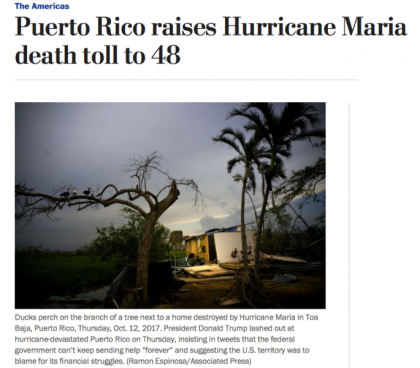Hurricane Maria touches Hesston, Kansas
by Jasmine Pankratz – Horizon Guest Writer

On Sept. 20, a Category 5 hurricane ripped through the heart of Puerto Rico with 155 mph winds, leaving majority of the island under water and without power. Approximately 3.4 million residents lost electricity, most lost precious belongings, and some lost lives. Hurricane Maria also affected Guadeloupe, the Leeward Islands, and the U.S. Virgin Islands in disastrous ways. The trauma of the storm even managed to reach Hesston, Kansas, where sophomore Carlos Rodriguez is a student and baseball player. But a Puerto Rican first.
For an entire week after the hurricane Rodriguez went to class, went to practice, did his homework, and played in baseball games, all while wondering if his family was okay. In Toa Baja, Puerto Rico, his grandparents, mother, and uncles weren’t able to call and let him know they were safe due to the power outage across the island.
“It was hard because I was supposed to pitch the day it happened and I just kept thinking about home,” Rodriguez said. “I missed a couple of classes because I couldn’t sit in a classroom and pay attention thinking about home.”
He was sitting in his dorm room after a day of classes when he got the call.
“I took a big breather when my mom called. She told me my house was fine, thank God.”
And Rodriguez continued to receive good news after hearing from his mom. All of his family members were safe despite not evacuating. All of their houses were fine. But the rest of his hometown was not. The official report from Puerto Rico’s Department of Public Safety says the death toll has hit 48. Numbers reported for To a Baja are murky, ranging anywhere from one to nine deaths. But one thing is clear. Those numbers are expected to rise.
“My mom said houses are flooded and in parts of the neighborhood all you can see are trees,” said Rodriguez. “A lot of people lost their houses. She said it’s all under water, like the sea.”
He’s grateful for all of the supplies his family received because others haven’t been as fortunate. After supplies are flown into Puerto Rico, they aren’t being transported all across the island. Truck drivers are scarce and hesitant because they don’t have fuel and can’t be reached by telephone. There’s an abundance of resources but no one to distribute them.
As a U.S. territory, Puerto Rico depends a lot on the mainland to help them. The media has criticized Donald Trump for his late response to the tragedy, and for not sending supplies sooner. The Trump administration didn’t begin assisting Puerto Rico until a week after what the governor of the island is calling, “the greatest catastrophe” in its modern history. But Rodriguez doesn’t completely agree.
“I don’t blame him because things don’t always run smoothly,” he said. “He’s sending help now and it did take a while, but better late than never.”
Rodriguez believes that if his home wasn’t a U.S. territory, then the situation would’ve been much worse. But that doesn’t mean Puerto Rico is helpless.
“Our governor and island are doing the best that they can.”
Rodriguez believes that Puerto Rico’s slow recovery is partially due to lack of experience with disaster. The last time a hurricane hit was 2004, but Rodriguez said they’ve never experienced one like this. And they never thought they would.
“When Hurricane Irma missed us it was a big relief for all of Puerto Rico,” Rodriguez explained. “Puerto Rico has a tendency to miss these storms. So when we heard about Maria coming we thought, ‘It’s gonna miss it.’ Then it came closer and closer and I thought, ‘This is really gonna happen.’ Then it went through the heart of Puerto Rico.”
Now two days short of one month, only 13.7 percent of the island has power. Prior to the hurricane, the Puerto Rico Electric Power Authority filed for bankruptcy and said it needed more than $4 billion to repair its outdated power plants and reduce its heavy reliance on imported oil, according to The Washington Post. Rodriguez believes this is a change to rebuild the electric grid and make it better. Restoring clean water is also a major issue right now as 63 percent of Puerto Ricans lack access. Another priority: helping San Juan, the city hit hardest, and a neighboring city 30 minutes away from Rodriguez’s hometown.
Despite the slow recovery, Rodriguez guarantees Puerto Rico will bounce back.
“We just care about surviving, and helping others,” he said. “It’s going to bring us together. We’re not gonna back down. Puerto Ricans believe. They always think about the good stuff, not the bad stuff.”
Although he is grateful that America and the Trump administration is helping Puerto Rico, there was a time when he thought his home was forgotten. The time between the moment the hurricane hit the island and the instant the first jet was sent over with supplies seemed like an eternity to Rodriguez. He had expected that.
But not from Hesston.
He could count on his hands how many people asked him about his family or his home. Most people still don’t know where he’s from and don’t care to ask. References in general were made towards the hurricanes and the Caribbean during chapel, but Puerto Rico itself wasn’t noted. It wasn’t mentioned at all.
“They didn’t even acknowledge it,” Rodriguez said.
But that doesn’t phase him.
“People forget that it’s a U.S territory but I don’t care if they care or not about Puerto Rico,” he said. “I didn’t expect them to care. Puerto Ricans haven’t complained and we’ll grow stronger from this.”
However, despite his confidence, the faith he has in his island hasn’t made it any easier on Rodriguez.
“If I could I would still go there right now,” he said. “I wish I was there when it happened.”
For information on how to help, visit FEMA.



